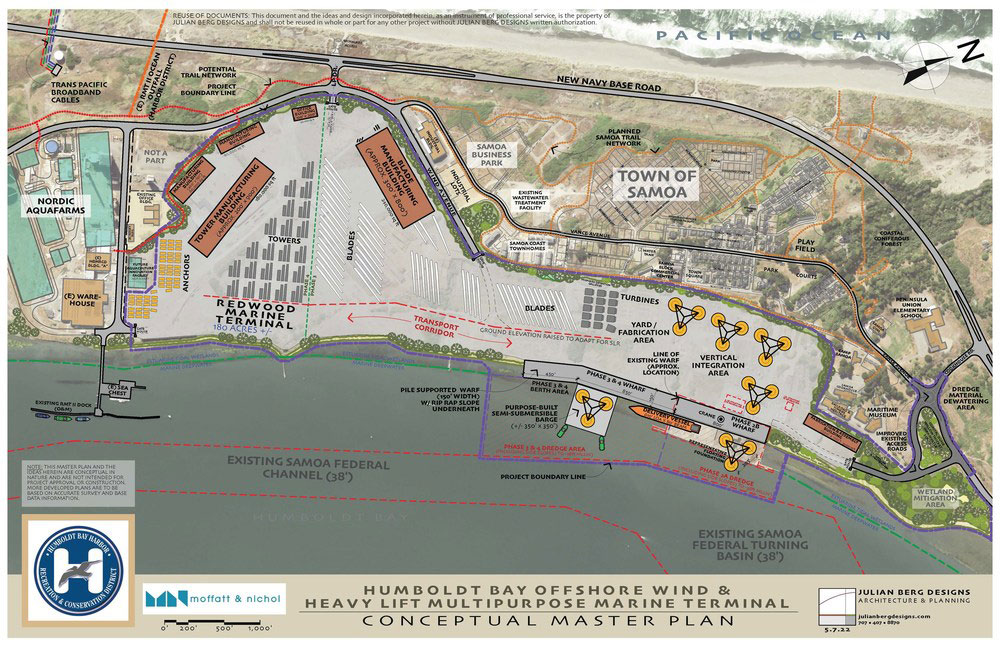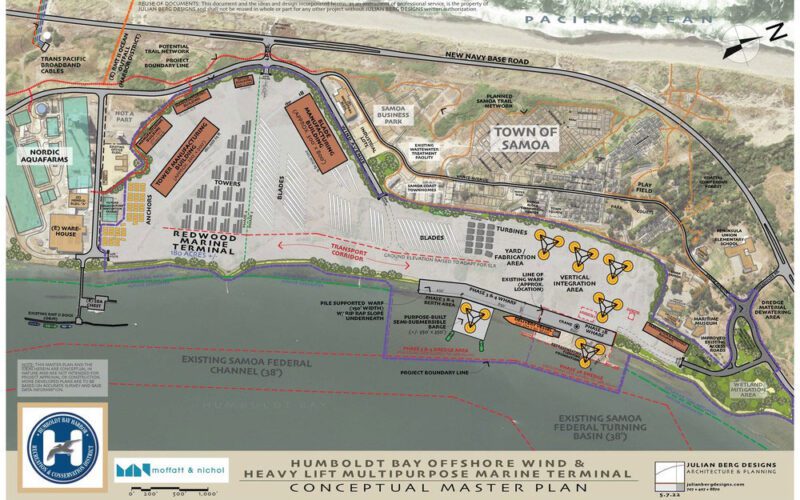
million homes.
There’s a strong wind blowing as the rush to develop offshore wind energy has reached almost hurricane force with both the U.S. private and public sectors racing to advance the technology at a fever pitch.
The U.S. currently has two operating offshore wind energy projects – the Block Island wind farm, four miles off the coast of Rhode Island with four turbines that produce 30 megawatts (MW) of electricity generation capacity, and the Coastal Virginia Offshore Wind pilot project which generates 12 MW of electrical power with a battery of turbines located 27 miles off Virginia Beach.
And more are on the way.
Crowley recently announced that it had reached a Right of First Refusal agreement to potentially lease and develop a 40-acre offshore wind terminal on 2,200 linear feet of prime waterfront property at Port Fourchon, Louisiana.
Last October, the Department of the Interior said that it would hold an offshore wind energy lease sale for areas on the Outer Continental Shelf (OCS) off central and northern California. The Florida-headquartered company moved quickly and signed an agreement with the Port of Humboldt Bay, Calif., to open negotiations to lease and serve as the port’s developer of its Humboldt Bay Offshore Wind Heavy Lift Marine Terminal.
The services provided at the proposed Terminal “will support tenants in the manufacturing, installation and operation of offshore wind floating platforms, use of large heavy cargo vessels and providing crewing and marshalling services in the Pacific waters,” Crowley said.
The Humboldt Bay project fits into California’s stated plan to generate at least 25 GW of offshore-produced wind energy 2045. The Humboldt offshore wind areas alone are projected to provide 1.6 GW of energy, capable of supplying power to up 1.6 million homes.
Crowley has also completed the acquisition of 42 acres at the Port of Salem, Mass., for the construction of a 42-acre logistics and operations center for offshore wind turbine assembly, transportation, staging, and storage at a vacant industrial facility. The development will include a 700-foot long wharf and 23 acres of land for a ‘lay-down area’ adjacent to the ‘load-out and assembly’ space.
More recently, the Biden Administration and the Department of the Interior recently approved the nation’s first-ever offshore wind energy lease sale which will open more than 300,000 acres of waters in the Gulf of Mexico with two sited off Galveston, Tex. and another off the coast of Lake Charles, La.
The proposed Gulf projects are part of the Biden Administration’s push to generate as much as 30 GW of offshore wind energy by 2030 – enough to provide electricity to more than 10 million homes.
Some $93 million in federal Port Infrastructure Development Grants has been earmarked to fund the dredging of the harbor and development of facilities at Bridgeport, Conn., “to assist offshore wind support vessels,” and the dredging of a new ship basin at Arthur Kill, on Staten Island, N.Y., “to support the further development of an adjacent 32-acre site as a purpose-built offshore wind staging and assembly facility.”
New York’s renewable energy agency, has unveiled a campaign to produce 2,000 megawatts of electricity at an offshore wind farm situated off the coast of Long Island, while General Electric has said it would build a pair of large offshore wind turbine manufacturing facilities at the Port of Coeymans, N.Y.
The plants will produce wind turbine blades and nacelles for the 14-megawatt, 900-foot tall Haliade-X wind turbines that will be installed at the Long Island wind farm. Each of the turbines is nearly 900 feet tall, three times the size of a regular onshore wind turbine, with blades that are longer than a football field.
The Port of Long Beach, Calif., has laid out plans for its Pier Wind facility, a 400-acre terminal with heavy-lift wharves specifically designed to accommodate outsize offshore wind components and serve as the assembly site for a battery of what is slated to be the world’s largest offshore floating wind turbine system.
The concept, with designs and assessments due for completion by the end of this year, calls for completed floated turbines to be towed by sea northward from Long Beach to offshore wind farms in federal waters some 20 miles off the coast of Central and Northern California. Funding for the Pier Wind project is being sought from both federal and state sources.
Massachusetts has set aside $75 million in state funds for offshore wind projects at the Port of New Bedford. The funds will go toward terminal expansion, as well as improvements to the boutique port’s existing facilities to accommodate the development of offshore wind capabilities. New Bedford is slated to be the site of New England’s largest offshore wind project and, when fully operational, is expected to generate enough electricity to power 750,000 homes.
The New Jersey Economic Development Authority has reached a lease agreement with two private companies to build an offshore wind port.
The state’s goal is to generate 11 GW of electricity from offshore wind energy by 2040 as part of its goal of transitioning to 100% clean energy by 2050 – an ambitious plan that would have New Jersey producing a full 30% of the offshore wind energy produced on the U.S. East Coast.

